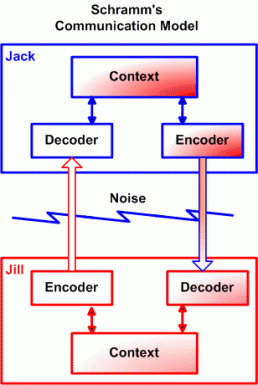The transactional model is a more realistic representation of human communication. It recognizes that both people involved in the interaction are communicators, and instead of the process illustrated as linear, it becomes circular in its function. Thus the process is an exchange. The two people engaged constantly respond to each other by initiating messages and sending responses back and forth (DeFleur, 2005).
1. Encode and decode messages: The individuals involved simultaneously act as sources and receivers.
2. Engage in role-taking and feedback: The messages and interpretation constructed by each individual are influenced by the role-taking assessments and the feedback they provide. As a person speaks, the other individual is simultaneously assessing his/her response on the basis of feedback and may be modifying parts of the message as well.
3. Influenced by prior communication: The messages people send and the manner in which they respond weigh heavily on what has been said previously.
4. Influenced by physical surroundings: Different environments contribute to different modes and methods of communication.
5. Influenced by the sociocultural situation: The message that is said and the manner in which it is delivered is part of an ongoing social situation that has rules for behavior.
6. Influenced by social relationships: The type of social relationship between the communicators, whether they be strangers or intimate, influences the transaction.
(DeFleur, 2005)

